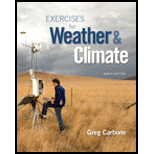
At 5° N latitude there are two peaks of incident solar radiation (that is, solar radiation striking Earth’s surface) during the year. Why does this location differ from other latitudes that have only one peak?
The reason why the
Answer to Problem 1E
Every latitude to the north of
Explanation of Solution
The region of the Earth receiving direct insolation from the Sun fluctuates seasonally during a year owing to the axial tilt, rotation, and revolution of the Earth. The daylight hours will be more in the region that is inclined more toward the Sun.
On June 21st, the day of June Solstice or Summer Solstice, the Sun will be directly above the Tropic of Cancer (
On December 22nd, the day of December Solstice or Winter Solstice, the Sun will be directly above the Tropic of Capricorn (
Unlike these latitudes, the Sun would be above the
Want to see more full solutions like this?
Chapter 4 Solutions
Exercises for Weather & Climate Plus Mastering Meteorology with eText -- Access Card Package (9th Edition)
Additional Science Textbook Solutions
Applications and Investigations in Earth Science (8th Edition)
Applications and Investigations in Earth Science (9th Edition)
Biochemistry: Concepts and Connections (2nd Edition)
University Physics Volume 3
An Introduction to Thermal Physics
Biochemistry: Concepts and Connections
 Applications and Investigations in Earth Science ...Earth ScienceISBN:9780134746241Author:Edward J. Tarbuck, Frederick K. Lutgens, Dennis G. TasaPublisher:PEARSON
Applications and Investigations in Earth Science ...Earth ScienceISBN:9780134746241Author:Edward J. Tarbuck, Frederick K. Lutgens, Dennis G. TasaPublisher:PEARSON Exercises for Weather & Climate (9th Edition)Earth ScienceISBN:9780134041360Author:Greg CarbonePublisher:PEARSON
Exercises for Weather & Climate (9th Edition)Earth ScienceISBN:9780134041360Author:Greg CarbonePublisher:PEARSON Environmental ScienceEarth ScienceISBN:9781260153125Author:William P Cunningham Prof., Mary Ann Cunningham ProfessorPublisher:McGraw-Hill Education
Environmental ScienceEarth ScienceISBN:9781260153125Author:William P Cunningham Prof., Mary Ann Cunningham ProfessorPublisher:McGraw-Hill Education Earth Science (15th Edition)Earth ScienceISBN:9780134543536Author:Edward J. Tarbuck, Frederick K. Lutgens, Dennis G. TasaPublisher:PEARSON
Earth Science (15th Edition)Earth ScienceISBN:9780134543536Author:Edward J. Tarbuck, Frederick K. Lutgens, Dennis G. TasaPublisher:PEARSON Environmental Science (MindTap Course List)Earth ScienceISBN:9781337569613Author:G. Tyler Miller, Scott SpoolmanPublisher:Cengage Learning
Environmental Science (MindTap Course List)Earth ScienceISBN:9781337569613Author:G. Tyler Miller, Scott SpoolmanPublisher:Cengage Learning Physical GeologyEarth ScienceISBN:9781259916823Author:Plummer, Charles C., CARLSON, Diane H., Hammersley, LisaPublisher:Mcgraw-hill Education,
Physical GeologyEarth ScienceISBN:9781259916823Author:Plummer, Charles C., CARLSON, Diane H., Hammersley, LisaPublisher:Mcgraw-hill Education,





